Last week’s Eredivisie had one of the biggest games of the season as PSV took on Ajax at Philips Stadion.
It was a potential title decider as the two teams were only separated by a one-point margin before the match, although Erik ten Hag’s men had a huge goal differences advantage over the opponents.
The two clashes of these two teams in October and August ended up with a 4-0 and 5-0, with PSV Eindhoven winning the Super Cup and de Godenzonen revenged later on.
The third clash between PSV Eindhoven and Ajax was a controversial one since the guests merely won by the goal of Noussair Mazraoui.
This Erik ten Hag tactical analysis explains the tactics of both sides, such as how Roger Schmidt adapted the opponents and made adjustments during the break.
Lineups
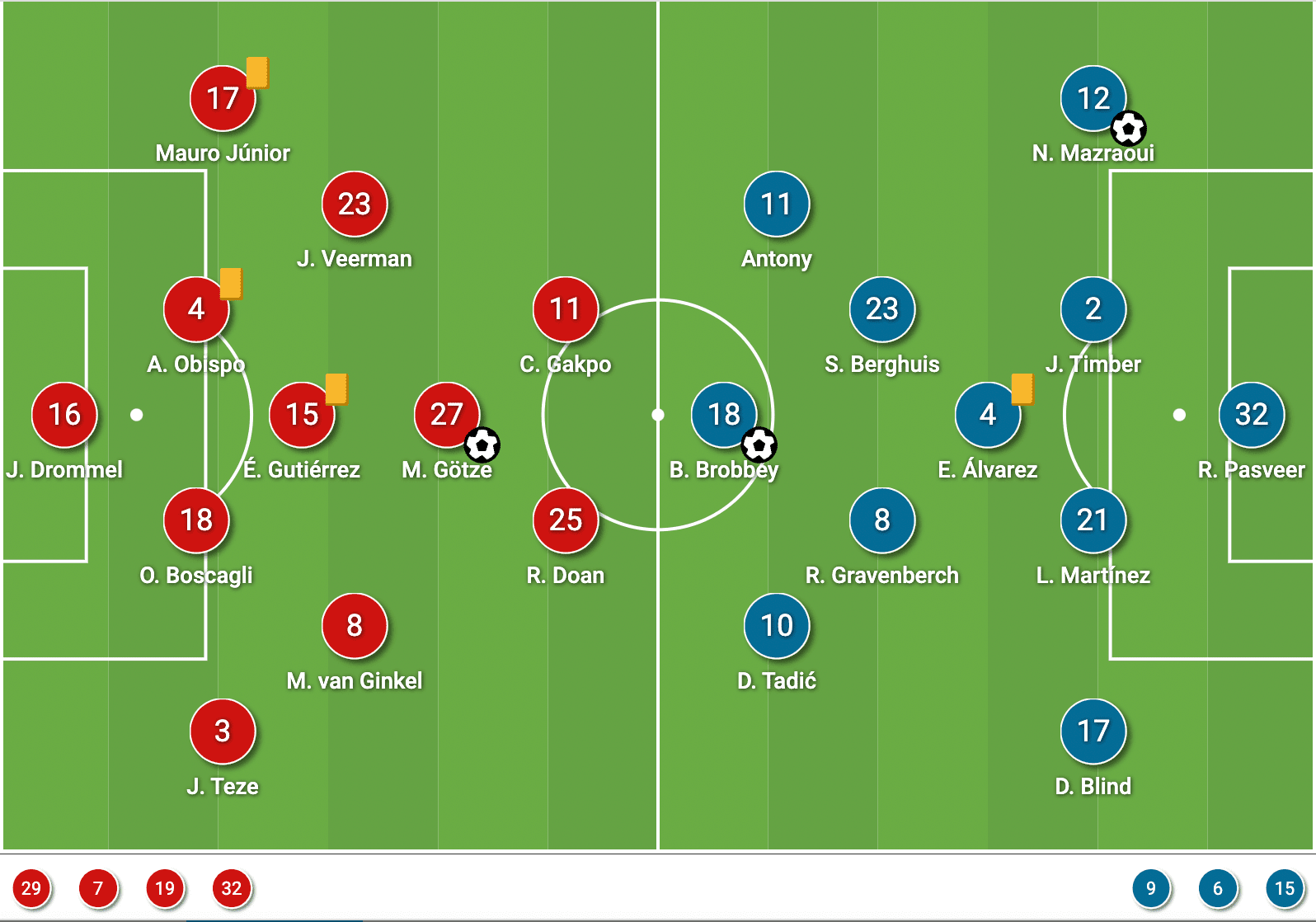
PSV did not come with their usual 4-2-3-1 or 4-4-2 formation since Schmidt chose a 4-diamond-2 or a 4-3-1-2.
They were missing some key players such as André Ramalho and Eran Zahavi, so Cody Gakpo paired up with Ritsu Doan as the strikers, with the former Borussia Dortmund attacker Mario Götze supporting as the 10.
Ajax played with their 4-1-2-3, the regular starters came back to the lineup after resting in the KNVB Beker.
Only Antony and Jurrien Timber started in that 9-0 win against Excelsior.
The midfield formed by Edson Álvarez, Ryan Gravenberch, and Steven Berghuis was phenomenal in this game, they contributed a lot to the victory.
Solving the PSV 4-d-2
PSV suddenly came with another formation in this game by shifting from a 4-2-3-1 to a 4-d-2 because the formation gave them more presence in the centre.
In this system, they could still possess the pace to harm the opponents with skilful 1v1 wingers playing narrowly as the strikers in the centre.
Defensively, they could have a 4v3 in the centre, which was a constant “+1” numerical advantage over Ajax’s midfield three.
However, it was a difficult game as ten Hag’s troops were well-drilled with different positional tactics to move the ball forward.
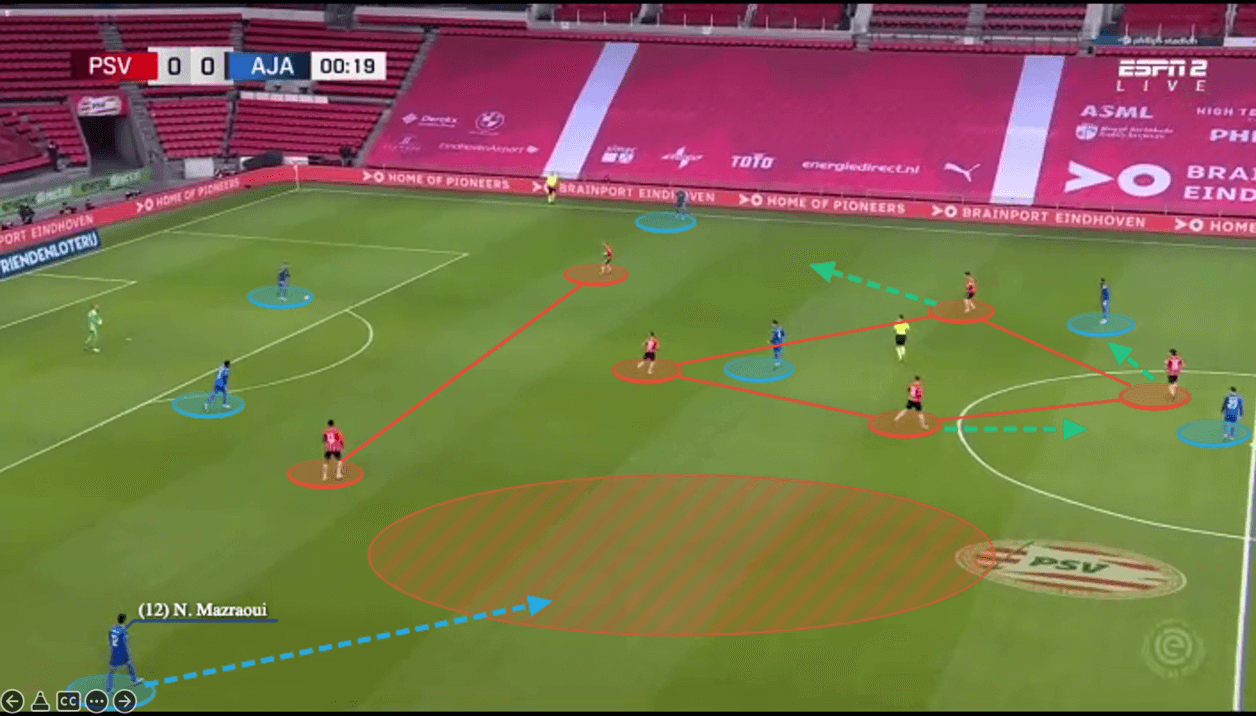
In PSV’s 4-d-2, they did not close the Ajax full-backs initially as letting the attack go to flanks could be a favourable pressing condition.
If the opponents were bounded by the touchlines, it would be easier to recover possession, and so PSV tried hard to stop the opposition from going inside.
Hence, Götze was assigned to man-mark the 6 of the opposition, and the strikers would use their bod orientation to block the centre-back’s passing lanes to full-backs, so they lurk the opponents to go inside.
The above image shows how PSV could press with the diamond in the centre.
If the ball goes to the flank, the wide midfielder could jump out to press the full-backs, and the striker would close the return passing lane to centre-backs.
To deal with the Ajax 8s, who would be free after the wide midfielders jumped out, the rest of the diamond shifted in clockwise or anti-clockwise directions as suggested above.
So, Érick Gutiérrez would take Gravenberch and Joey Veerman would be responsible for Berghuis.
But note that Ajax players’ positionings were not fixed.
As we indicated in the above screenshot, the right-back, Mazraoui could go infield to receive the ball and that became a key progressive route for the guests.
We would explain more later.
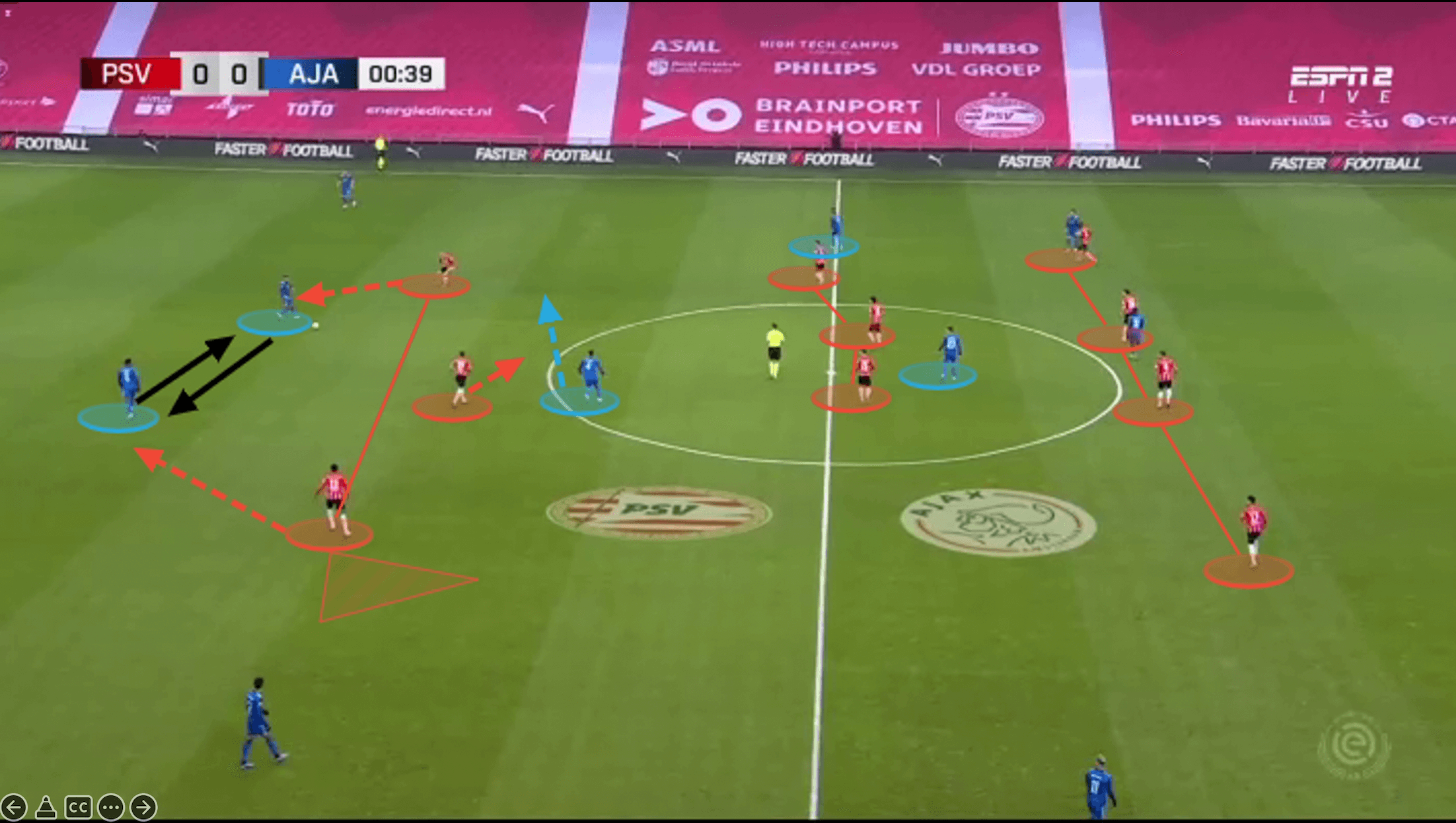
If PSV pressed, they would use the strikers to press the centre-backs from the diagonal angles, so they blocked the passing lanes to full-backs when accessing the oppositions.
The press could come with diverse timings as they wanted to apply continuous pressure on the opponents.
For example, centre-backs exchanged passes, the first pass to Lisandro Martínez would attract Doan, but the Argentine international could not find Álvarez as Götze was man-marking the Ajax 6.
When the pass went back to Timber, Gakpo would come to execute another press.
Then, they had the intensity to keep the opponents playing outside them or going back to the keeper.
But even Ajax could find Álvarez, who was good at moving on the blindside of the marker, PSV were still safe in the centre given three players were shielding spaces in front of the last line.
The “3” of the 4-3-1-2 should be staying compact and cover the Ajax 8s, intercepting the ball if the opponents tried to play through them.
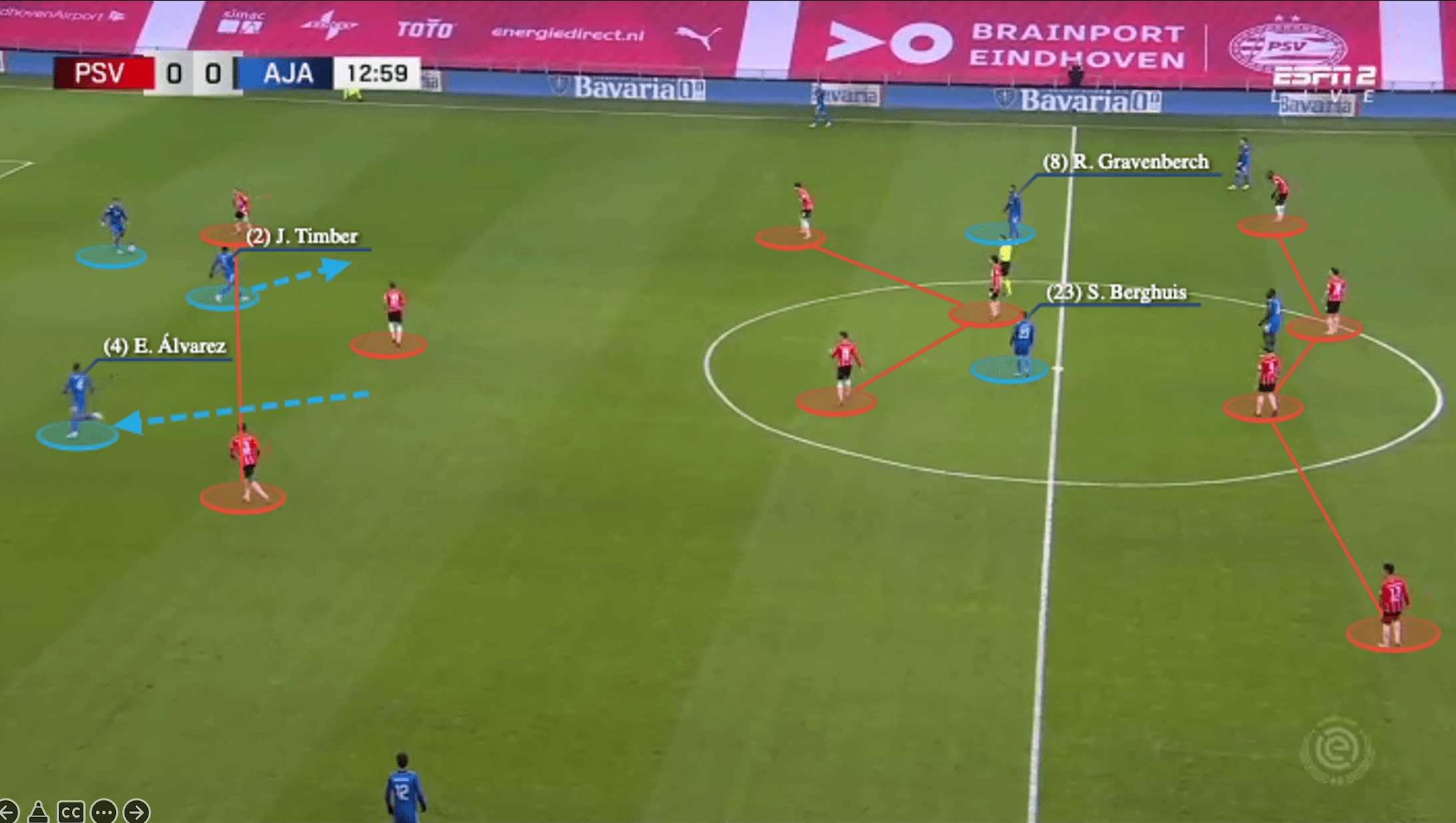
But Ajax had a great strategy to destroy the defensive plan of PSV.
To ruin the man-marking plan of PSV, the players rotated to create decisional dilemmas through movements.
The above image shows Álvarez dropping to the first line, and Timber moved forward when Martínez had the ball.
The movements were simultaneously so Götze was uncertain about how to react, and kept focusing on Álvarez until realizing it was too late to stop Timber from receiving.
Note that the Ajax 8s (Gravenberch & Berghuis) were usually staying high and behind the PSV midfielders to manipulate the second line.
That separated the opposition block vertically to open more spaces in the build-up, so Timber could receive with spaces in front after bypassing the first line.
Of course, it was also a solution of PSV as the midfield three were staying tight to block the passing lanes towards the Ajax 8s, but can these narrow midfielders stop the full-backs when the PSV full-backs were occupied by the opposition wingers?
The move between Timber and Álvarez became a crucial one as that became the start of the Brian Brobbey goal.
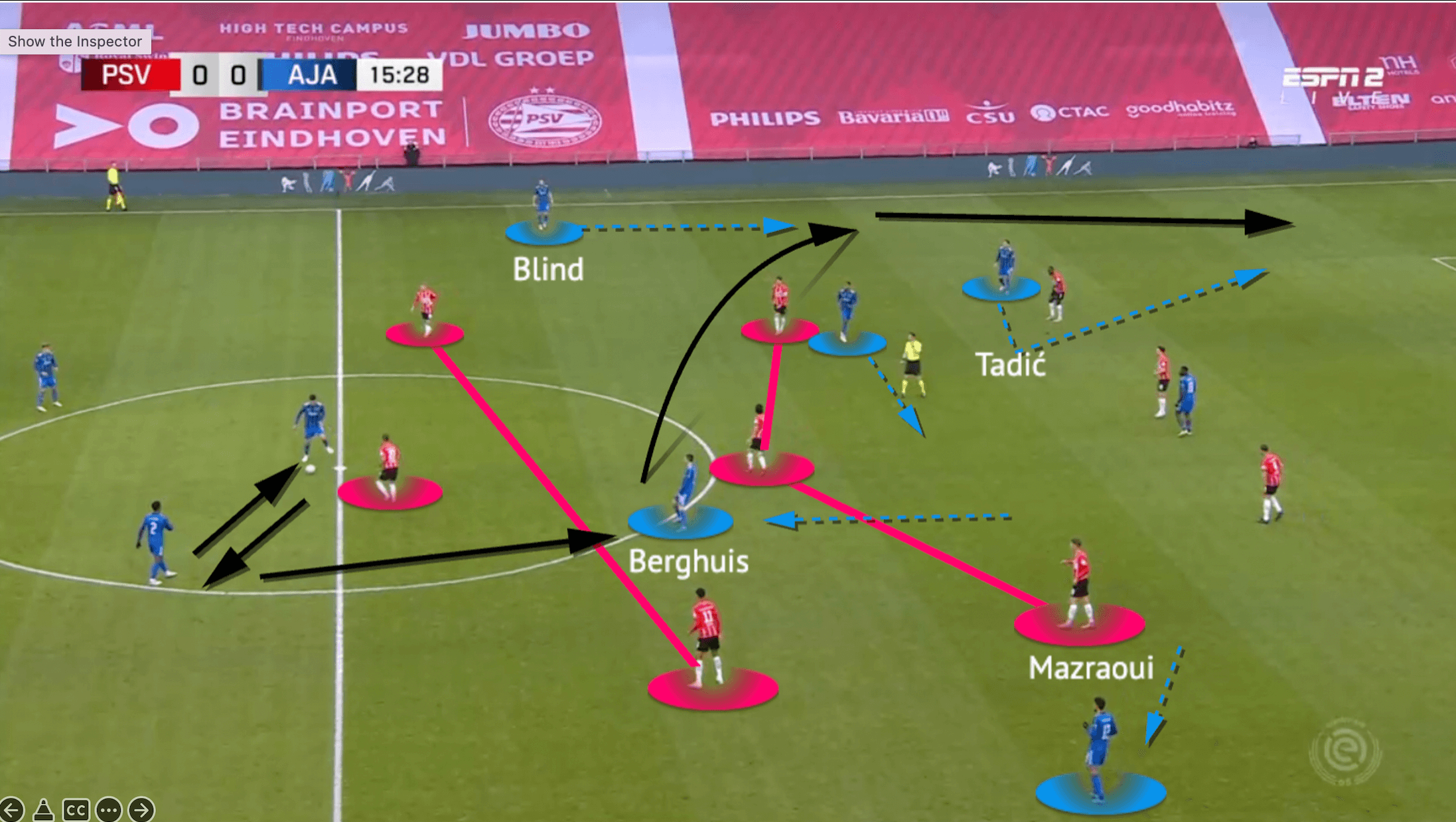
The way Ajax plays football shows they are a top team in Europe, their attacks can involve six to eight, or even more players together, which demonstrates football as a team sport, and how the players were helping each other to achieve the greater goods.
The above image was an impressive example of how Ajax were able to move the ball from side to side.
Positional tactics including wall pass, rotation, manipulation of the second line, and fixing the last line were all demonstrated.
Mazraoui initially went infield to form a three-man midfield inside PSV’s block, numerically that equalled the “3” of PSV’s 4-3-1-2.
Then, Mazaroui slightly moved wider to drag the stretch that horizontal chain, while Gravenberch also drifted inward to pull the wide midfielder on the other side to go inside, the wide spaces were opened for the Ajax left-back to exploit.
The function of the wall pass was to invite the press of Götze, so Timber would have spaces to pass forward when the ball came back.
If Ajax played inside the block, they had Berghuis dropping at the right moment of receiving as he could play in spaces.
The 30-year-old Dutchman was good at releasing the wide runners on the left flank too, he found Daley Blind after turning in that pocket of space.
Another two important players were Dušan Tadić and Brobbey.
The RB Leipzig loanee stayed in the centre to occupy the centre-backs, while Tadić made an inside movement to engage the right-back, so Blind was not receiving pressure when Berghuis switched the ball.
As we mentioned one by one, almost the entire team played a part in this attack.
No more man-marking on Álvarez
Apart from the above tactics, Ajax also had Mazraoui coming infield to receive in the half-spaces, the Moroccan right-back was good at moving on Gakpo’s blindside to free himself.
In the first half, Blind was rather wide and the roles of full-backs changed in the second 45.
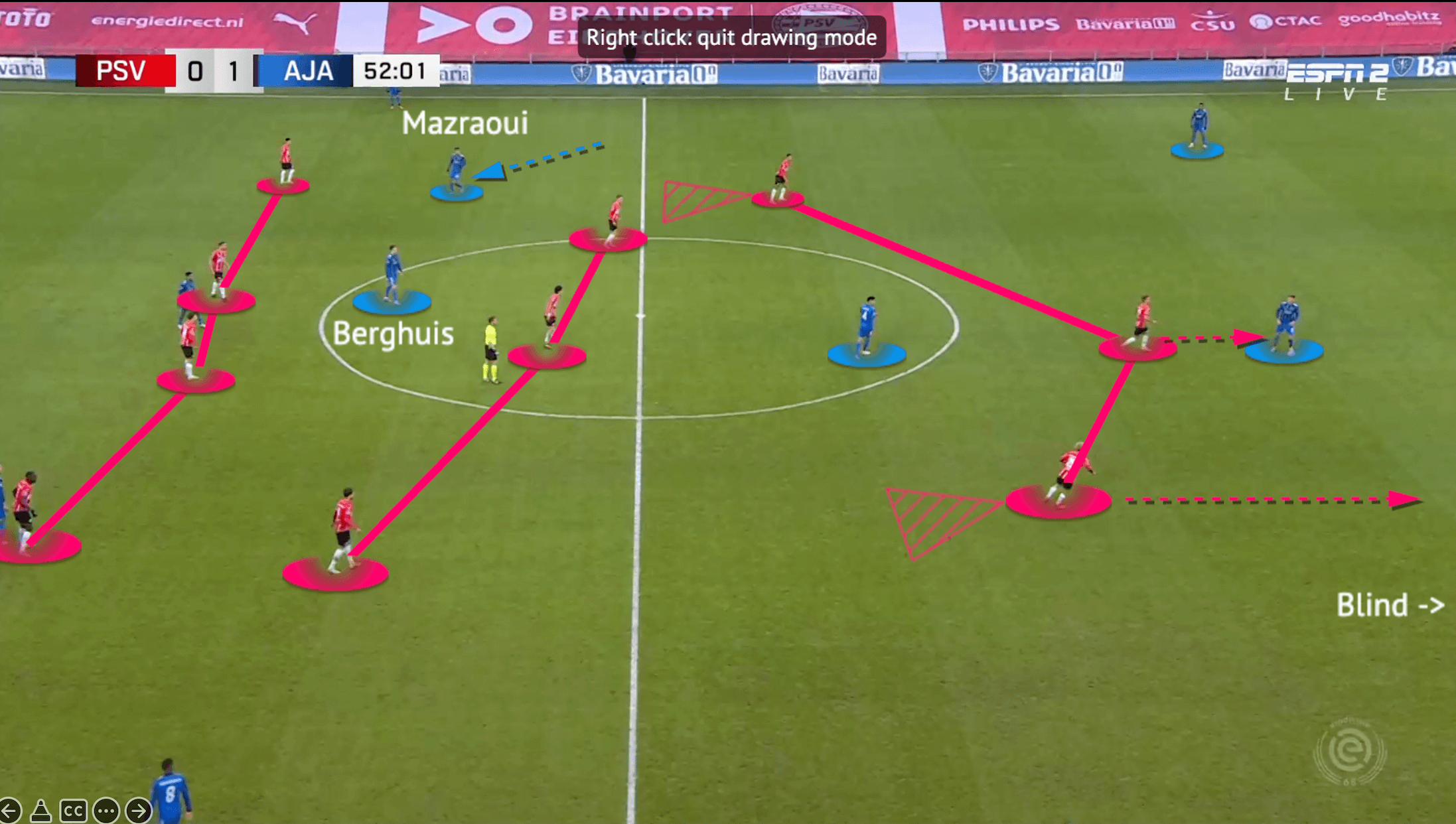
Because of how easily Ajax were able to manipulate the man-marker, Schmidt abandoned this approach and wanted his side being more aggressive to press high up on the pitch.
Götze no longer man-marked Álvarez and went higher to press the centre-backs, which was liked a 4-3-3 formation with the two wingers (Gakpo & Doan) staying narrowly in the half-spaces to block those zones.
Ajax responded by giving hybrid roles to the full-backs, no longer hugging the touchline or staying out wide, but more often drifting into the centre to create spaces for others.
For example, Blind stayed deep as the left centre-back to establish a 3-1 structure that created a 4v3 overload over the first line of PSV’s 4-3-3.
Also, Mazraoui stayed behind the PSV 8 earlier to manipulate the second line with Berghuis as shown above.
With the additional player in the second line, Gravenberch could play in wider spaces and outside of the block more to free himself in advanced areas of the attack.
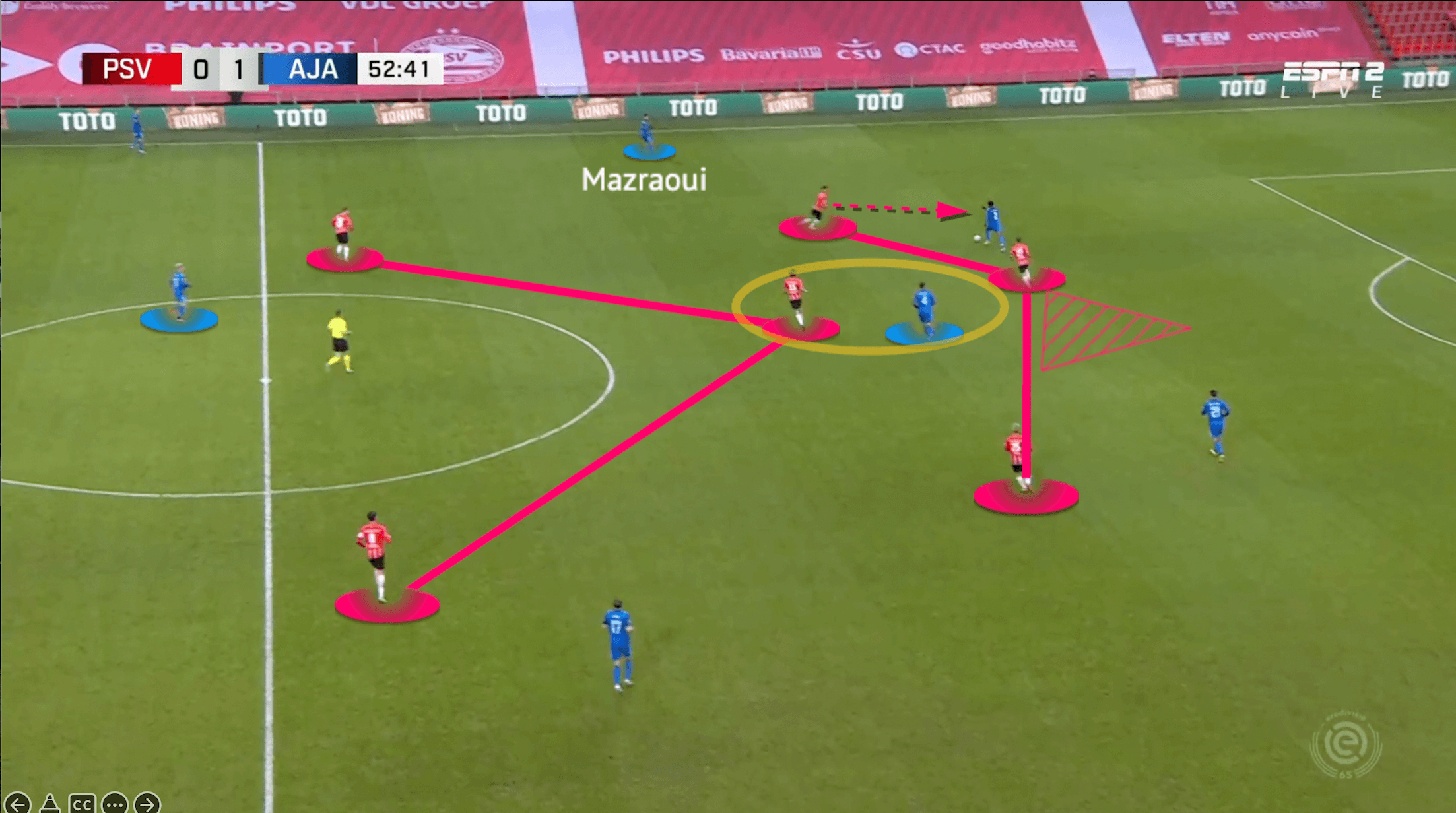
The new and more intense pressing helped PSV to score the equalizer.
The above scenario was the pressing before they recovered possession in the opposition third.
When Ajax were moving the ball in the final third, PSV players came up high to press them with Götze to cut the passing lane between centre-backs, that was something they did not do regularly in the first half.
Meanwhile, the midfielder (Gutiérrez) jumped out to close Álvarez, so they stopped the opponent from passing into the midfielder.
Then, since Gakpo was very close to the centre-backs initially because of his narrow positioning, and that’s the reason for his successful block on the pass to Mazraoui.
Timber might have done better by opening a wider angle to find the right-back but the intensity of PSV deserved credits too.
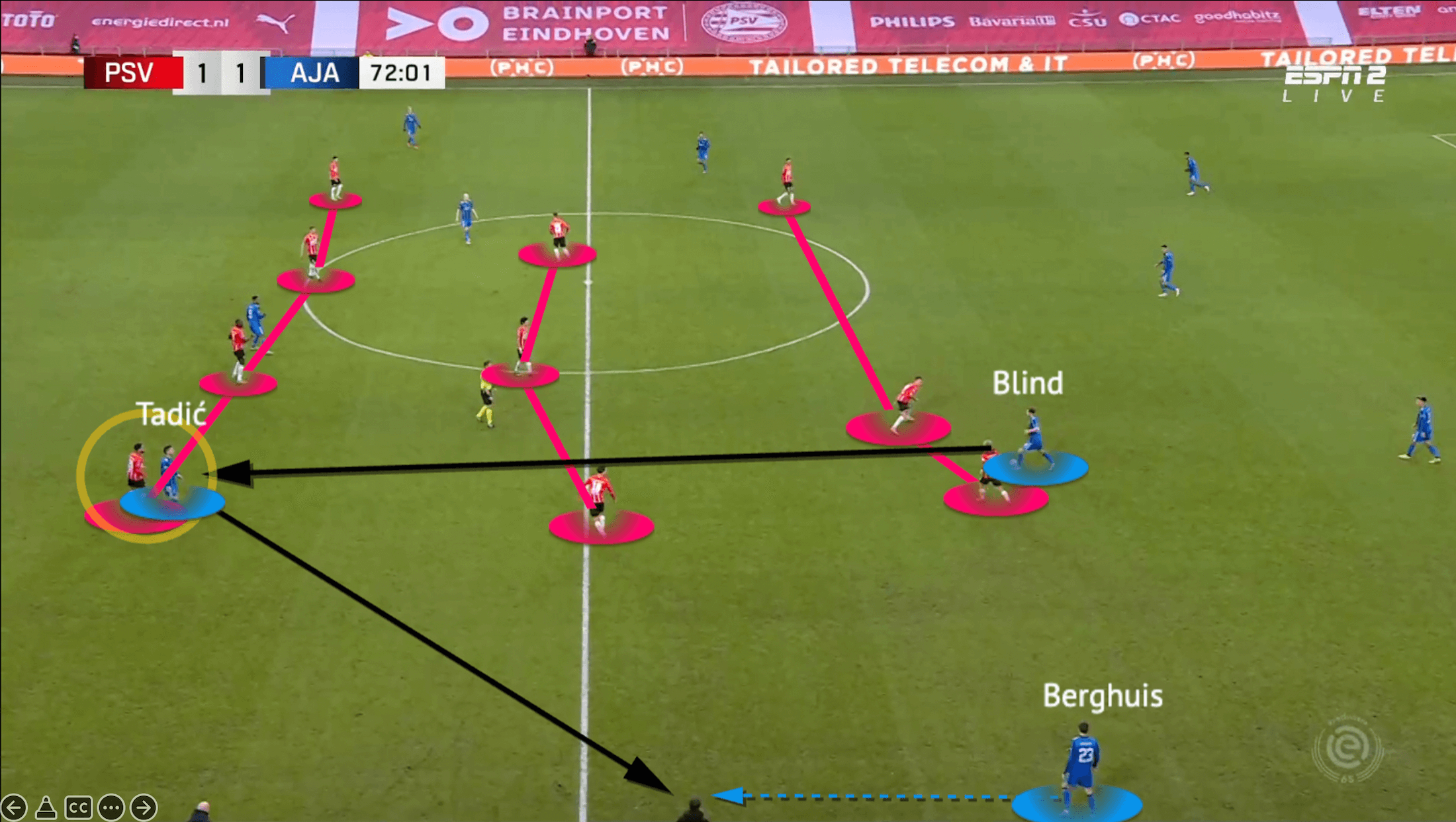
But Ajax were a competent and well-trained team that could pose different questions to the opponents.
For example, there were more rotations on the left side as we showed in the above image.
Tadić continued to occupy the PSV right-back in an inside position, and that exploited the narrow 4-3-3 block as the wide spaces were more exposed.
Blind, who began the play in the central more, could play the vertical passes to find Tadić.
The Serbian winger was good at playing in front of the defence with his quick decisions and tidy touches and releasing the player in the outside (Berghuis).
That forward spaces in front of the receiver gave the receiver the licenses to further drive forward, bringing plays into the opposition half.
Right flank verticality
PSV did not create too many chances in the second half, but they had an interesting approach in the first half that demonstrates the attacking philosophy of Schmidt.
The former RB Salzburg and Bayer 04 Leverkusen head coach believed the team should attack with verticality and minimum widths, so they packed the right flank with so many players in the offensive phases.
That side was their main source of attacks apart from the transition phases.
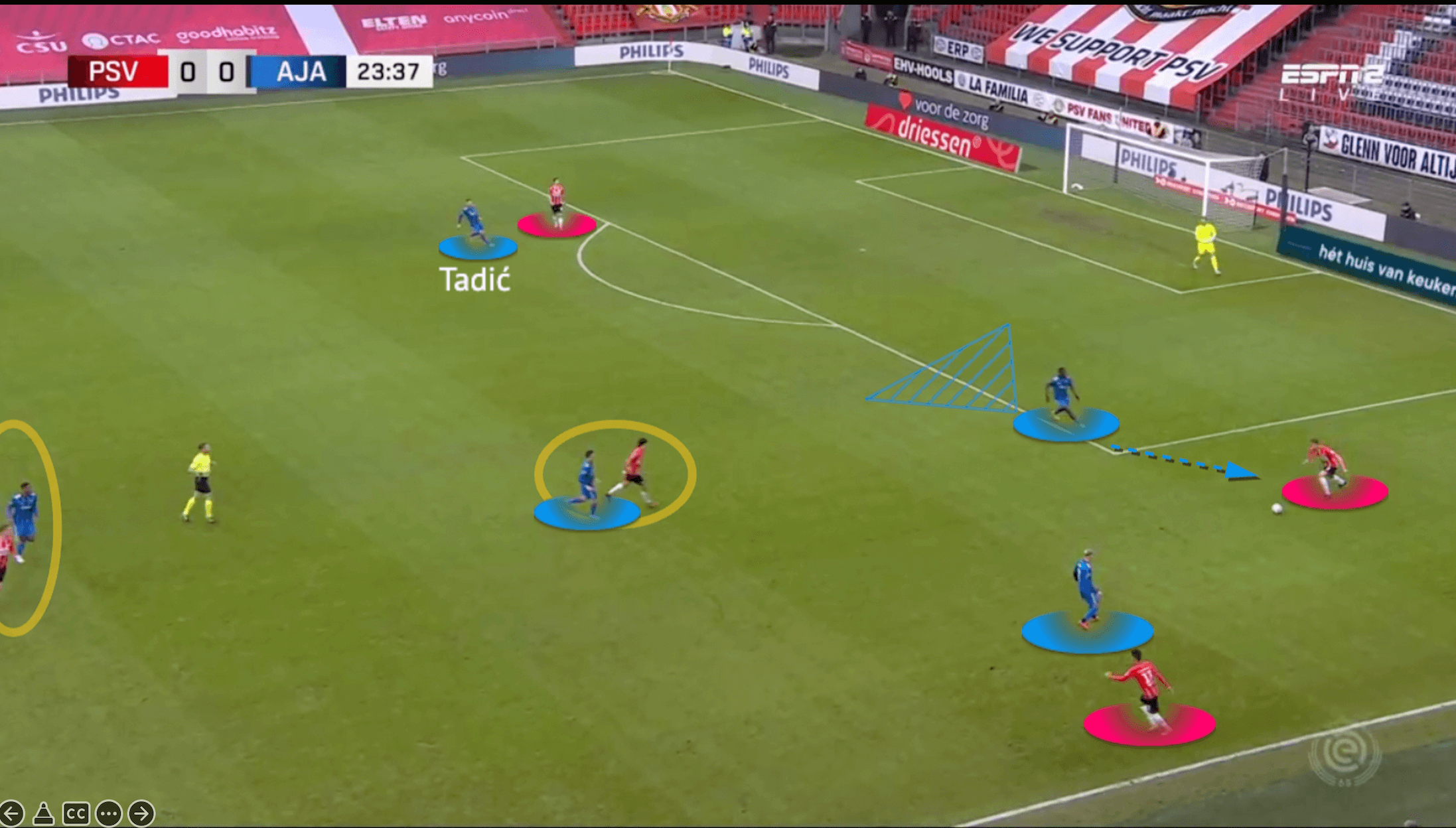
The pressing of Ajax was in a 4-2-3-1 shape.
They would try to press in one flank and keeping the opposition in the same side, so they defended in smaller spaces with a more compact shape in general.
AS shown in the above image, the striker mostly initiated the press by cutting the passing lanes between centre-backs, so PSV could not circulate comfortably in the backline, unless they used Joël Drommel.
Also, the far side winger (Tadić) came inner to close the far side centre-back as well.
Then, the winger on the ball side can close the full-back (Antony on Mauro Júnior).
In the midfield, the marking was rather tight, such as Berghuis closing down Gutiérrez here, forcing the opponents to play long would be an ideal situation as the last line could compete for an aerial duel with an “+1” advantage, even Götze was high.
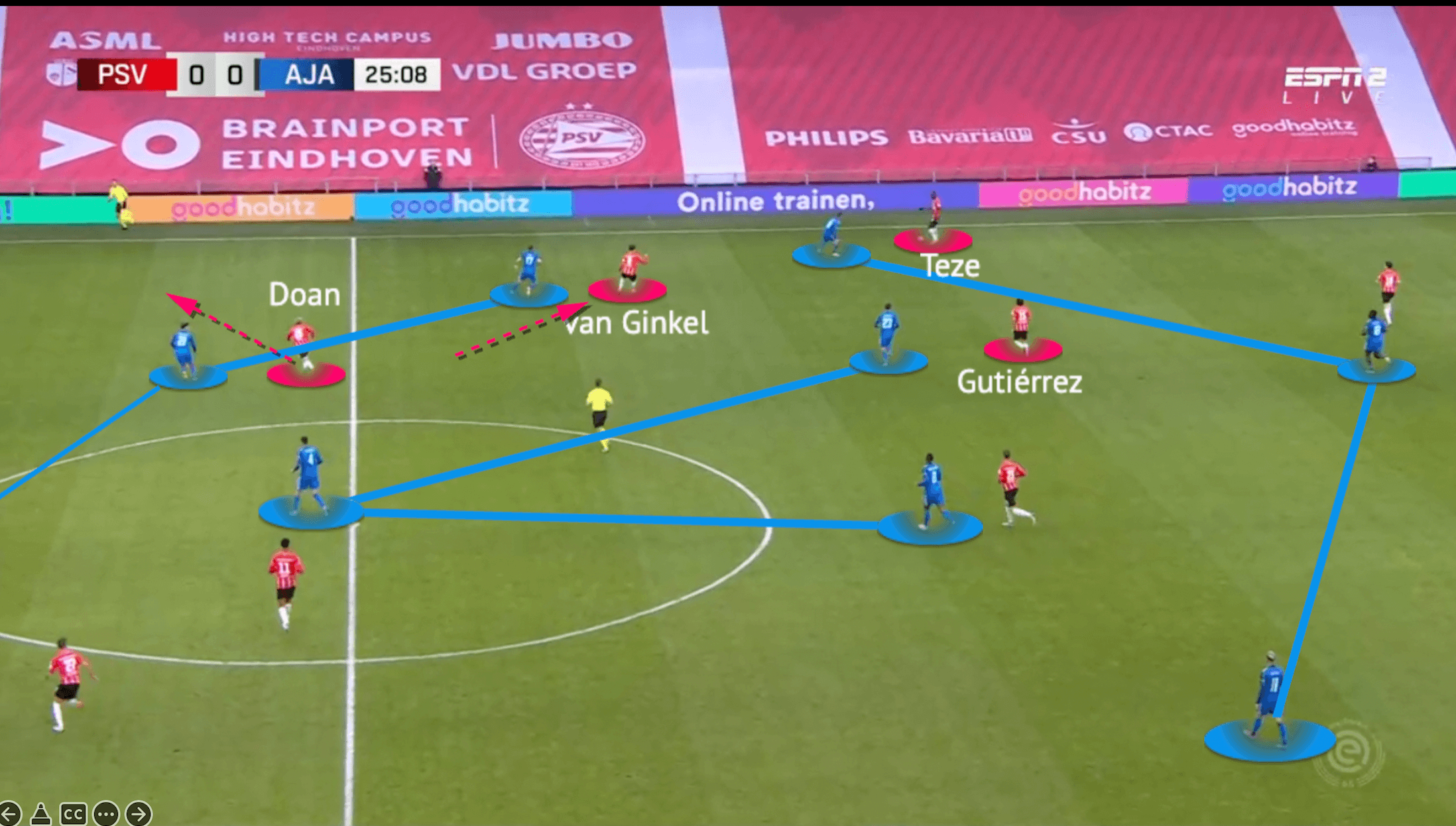
To maximize the threat of their quick attackers against the high line of Ajax, PSV also had some interesting moves to open spaces behind and exploit the defence.
In the above scenario, Ajax became a 4-1-2-3 with two 8s closing down Gutiérrez and Veerman.
Then, Marco van Ginkel dropped towards the ball to pull the left-back out, Blind was forced to step up or else van Ginkel would be free.
Simultaneously, Doan made a run in the reversed direction as now it was a 1v1 opportunity against Martínez, PSV were quite good at creating these isolations to allow the quality attackers to go behind.
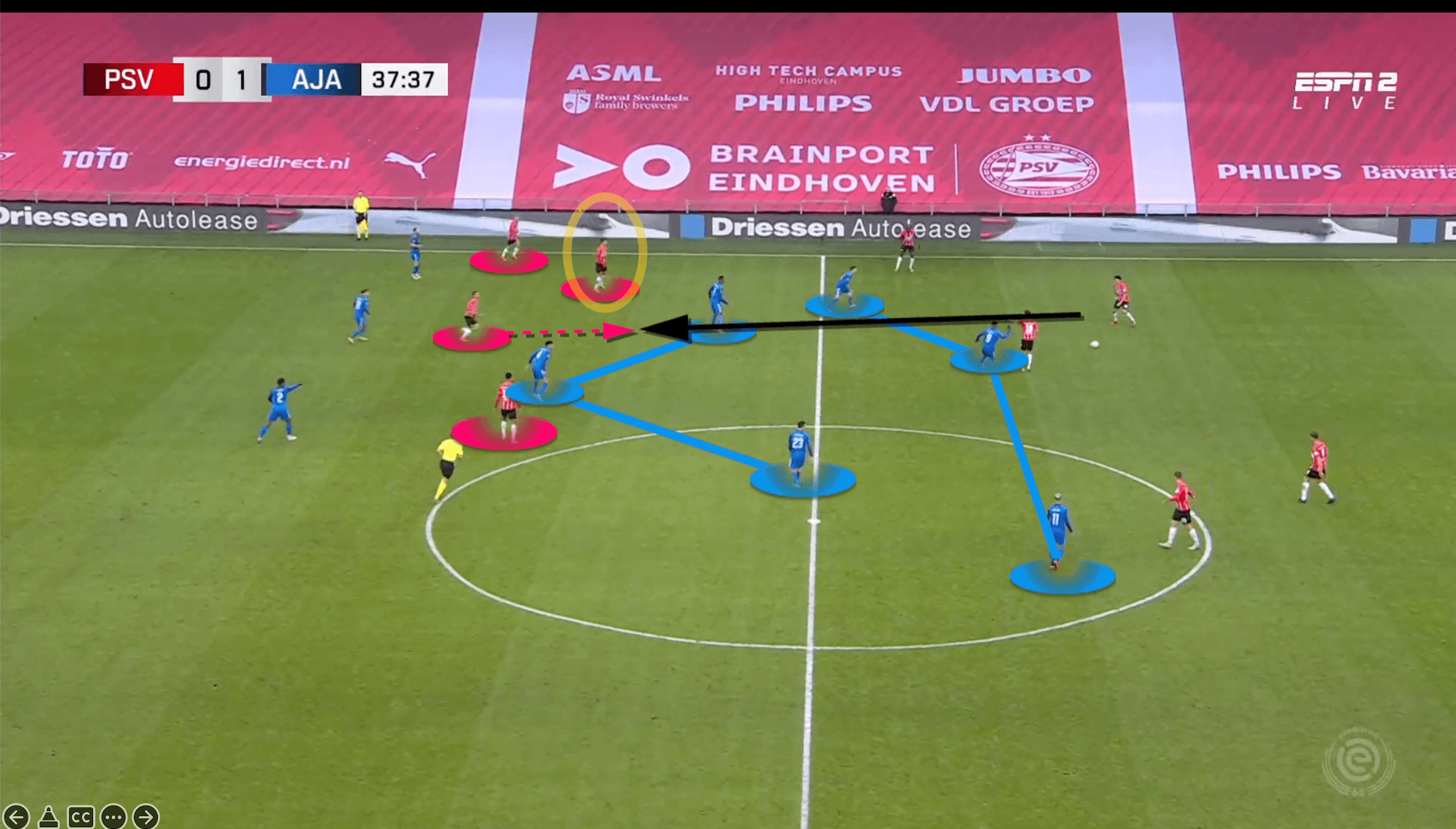
But moving in behind was not the only option as PSV had the dynamic Götze as the 10.
The World Cup winner was flexible in his positioning and good at exploiting the right space.
For example, here, we circled van Ginkel who drifted wider, that little adjustment of position fixed Gravenberch’s attention, so the Ajax 8 was also a few steps towards the touchline.
Those few steps made the difference as the passing lane was now opened on the left side of Álvarez.
This time, it was not going behind because the centre-backs were not jumping out, so the receiver (Götze) should drop and try turning in that pocket of space.
Conclusion
Although the game was only a narrow 2-1 win for Ajax, we felt ten Hag’s men were more deserved the three points as they controlled the game firmly.
Schmidt mentioned the referee was the reason for the loss in the post-match interview, but as this analysis has shown, there were many departments that required improvements.
This game was a potential title decider, but the season has not ended yet unless Ajax could win 14 games straight without any dropping points.
If PSV could regroup and react after this loss, they still stand a chance for the league title and we would expect them to continue the race until May!





Comments